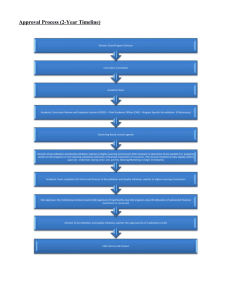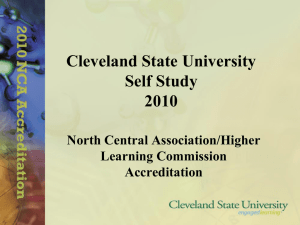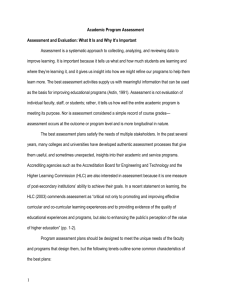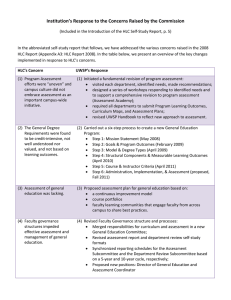University Assessment Committee
advertisement
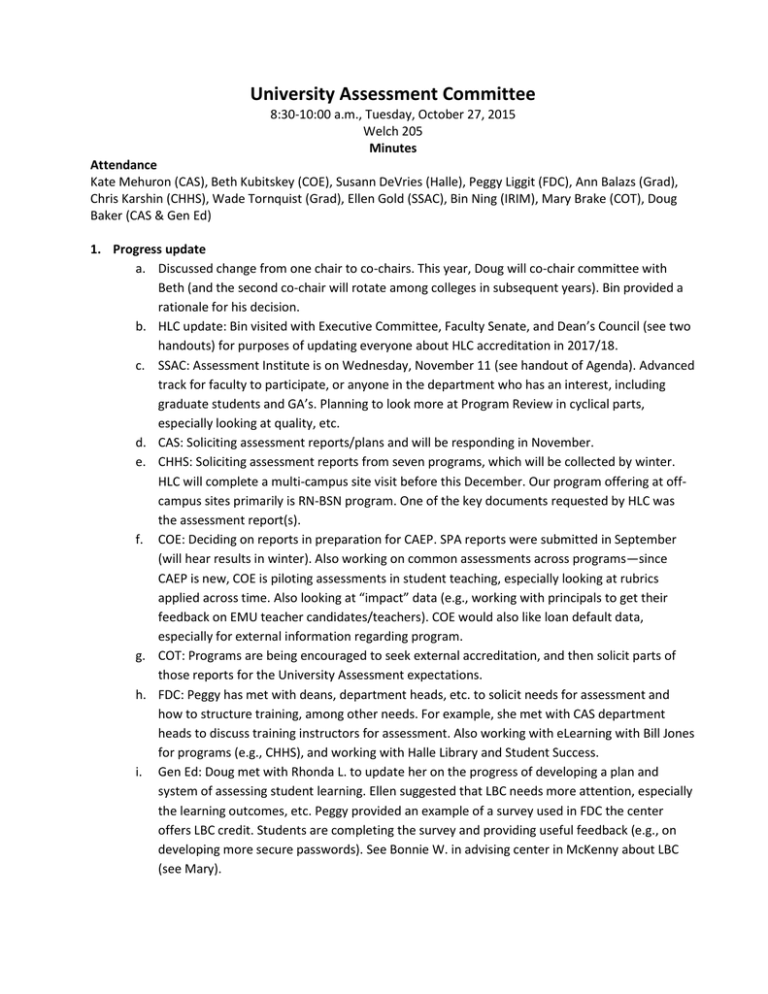
University Assessment Committee 8:30-10:00 a.m., Tuesday, October 27, 2015 Welch 205 Minutes Attendance Kate Mehuron (CAS), Beth Kubitskey (COE), Susann DeVries (Halle), Peggy Liggit (FDC), Ann Balazs (Grad), Chris Karshin (CHHS), Wade Tornquist (Grad), Ellen Gold (SSAC), Bin Ning (IRIM), Mary Brake (COT), Doug Baker (CAS & Gen Ed) 1. Progress update a. Discussed change from one chair to co-chairs. This year, Doug will co-chair committee with Beth (and the second co-chair will rotate among colleges in subsequent years). Bin provided a rationale for his decision. b. HLC update: Bin visited with Executive Committee, Faculty Senate, and Dean’s Council (see two handouts) for purposes of updating everyone about HLC accreditation in 2017/18. c. SSAC: Assessment Institute is on Wednesday, November 11 (see handout of Agenda). Advanced track for faculty to participate, or anyone in the department who has an interest, including graduate students and GA’s. Planning to look more at Program Review in cyclical parts, especially looking at quality, etc. d. CAS: Soliciting assessment reports/plans and will be responding in November. e. CHHS: Soliciting assessment reports from seven programs, which will be collected by winter. HLC will complete a multi-campus site visit before this December. Our program offering at offcampus sites primarily is RN-BSN program. One of the key documents requested by HLC was the assessment report(s). f. COE: Deciding on reports in preparation for CAEP. SPA reports were submitted in September (will hear results in winter). Also working on common assessments across programs—since CAEP is new, COE is piloting assessments in student teaching, especially looking at rubrics applied across time. Also looking at “impact” data (e.g., working with principals to get their feedback on EMU teacher candidates/teachers). COE would also like loan default data, especially for external information regarding program. g. COT: Programs are being encouraged to seek external accreditation, and then solicit parts of those reports for the University Assessment expectations. h. FDC: Peggy has met with deans, department heads, etc. to solicit needs for assessment and how to structure training, among other needs. For example, she met with CAS department heads to discuss training instructors for assessment. Also working with eLearning with Bill Jones for programs (e.g., CHHS), and working with Halle Library and Student Success. i. Gen Ed: Doug met with Rhonda L. to update her on the progress of developing a plan and system of assessing student learning. Ellen suggested that LBC needs more attention, especially the learning outcomes, etc. Peggy provided an example of a survey used in FDC the center offers LBC credit. Students are completing the survey and providing useful feedback (e.g., on developing more secure passwords). See Bonnie W. in advising center in McKenny about LBC (see Mary). j. Grad: Working to promote good habits of assessment of student learning. Planning to focus on assessment and review of graduate programs. k. Halle Library: Assessment team met and working on Canvas. Pilot study (of a few classes) very successful. Appointments with subject area librarians are rising. There is data that can be used for Gen Ed (professors use basic information literacy rubrics and can incorporate in course shell). Note on Accreditation Reports for external accreditation We will develop a unified position on how we incorporate external accreditation reports, especially on direct assessment. 2. HLC Reviewer Training – October 21-23. Doug provided overview of the training, particularly for how we might improve our internal processes toward accreditation, etc. The Higher Learning Commission organized training for new peer reviewers and new team leaders. Each day participants met as a group to listen to HLC representatives describe approaches to conducting reviews of institutional accreditation reports and for preparing and conducting campus visits. Participants also met in teams to review an example report and to go through processes of evaluation. Three key aspects of the training suggest potential action for EMU: (1) incorporating the core values of the HLC into EMU’s plans—see next page*; (2) responding professionally and accurately to institutional reports; (3) and training others as internal reviewers and observers of assessment practices. Potential Plans to Incorporate Ideas Constructing Website: Reviewers are encouraged to dedicate at least 30 hours to reading and preparing to respond to an institutional report and to plan the campus visit with the team, especially deciding on areas of focus and who to meet with on campus. The website becomes important for two main reasons: it is the introduction to the institution and it provides potential alignment with the report, and reviewers will look for this alignment. So, structure website so it aligns with report (e.g., university mission and student learning, or mission and finances, etc.). Aligning Mission with Other Criteria: The first HLC criterion should link to all of the others. So, consider how the parts connect. Therefore, team leaders should become aware of all criteria and see links; and team leaders, among others, should meet to see how threads of an idea are linked across the report and criteria. Representing Core Values: The HLC has a list of 10 core values—see next page*. How do EMU’s values, ones listed on the website, connect with these? So, consider making visible the EMU values and how the criteria reported are linked; and consider making links with HLC’s stated values when appropriate. Responding to Reports: Three key aspects of response could be integrated in what we do at EMU. When responding to reports, writers must consider the following: (1) Context; (2) Evidence; (3) Judgment. For example, CASAC responds to all program reports. However, the committee should consider making transparent the principles it uses to respond to reports and how it aligns with the approach HLC uses to train reviewers. Furthermore, the response should include professional judgment about how well the program has represented its assessment plans or report. 3. Fall 2015 Work Plan Building momentum on “Closing the loop”: Using assessment results to make changes and improvements (All). Bin requested that we consider within our colleges how we plan to address this theme, particularly for preparing for a fall 2016 event on the theme. November meeting into a retreat (2-hour session). Common readings. What does closing the loop look like? Examples? How to prepare others for closing the loop? Doug will sent a “guided reading” in preparation, including questions that can guide us. What do we want to leave the retreat with? For example, remind ourselves that we are leaders of assessment, so finish the retreat knowing how we are going to help faculty/staff in our colleges, etc. Another goal: get ideas about how to coordinate public forums. Another: Will the readings suggest changes in our templates for spring reports? Assign discussion leaders for each goal. Maybe bring a key assessment leader from our areas. 5. Next meeting: 8:30-10:30am, November 17, Welch 205 Comparison of Values* Higher Learning Commission The Criteria for Accreditation: Guiding Values EMU Core Values https://www.emich.edu/studenthandbook/emu-values.php https://www.hlcommission.org/Criteria-Eligibility-andCandidacy/guiding-values-new-criteria-for-accreditation.html 1. Focus on student learning 2. Education as a public purpose 3. Education for a diverse, technological, globally connected world 4. A culture of continuous improvement 5. Evidence-based institutional learning and self-presentation 6. Integrity, transparency, and ethical behavior or practice 7. Governance for the well-being of the institution 8. Planning and management of resources to ensure institutional sustainability 9. Mission-centered evaluation 10. Accreditation through peer review Excellence: We provide an exceptional environment to our faculty, staff, and students. We improve our performance continuously and strive to be the best in everything we do. (1, 4) Respect: We care for our people, communities, and the environment and show respect for the dignity of the individual. (1, 6) Inclusiveness: We create an environment that supports, represents, embraces, and engages members of diverse groups and identities. (1, 2, 3) Responsibility: We are accountable – individually and in teams – for our behaviors, actions, and results. We keep commitments. (6, 7) Integrity: Integrity and transparency are critical to our institutional effectiveness. We pursue the highest level of personal, intellectual, academic, financial, and operational integrity within the University community. (1, 4, 5, 9)
